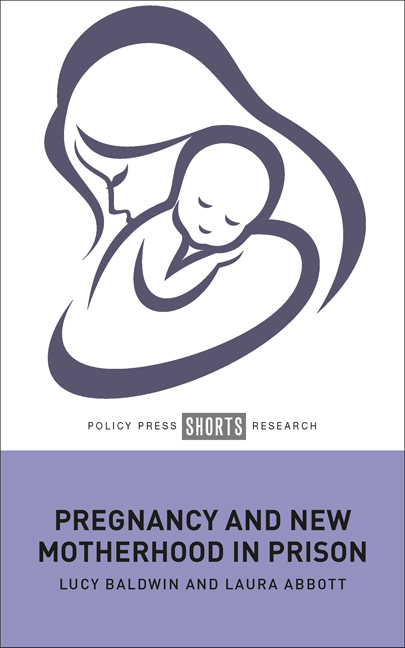Book contents
- Frontmatter
- Dedication
- Contents
- Acknowledgements
- ONE Context and landscape of pregnancy and new motherhood in prison
- TWO How we came to be here: 100 years of criminalised motherhood
- THREE The ‘journey’ to incarcerated motherhood
- FOUR Motherhood confined
- FIVE The persisting pain of incarcerated pregnancy and new motherhood
- SIX Personal experiences of pregnancy and motherhood in prison and the value of the voluntary sector in challenging the system
- SEVEN ‘Learning lessons’: discussion, concluding thoughts and recommendations
- Notes
- References
- Index
FOUR - Motherhood confined
Published online by Cambridge University Press: 03 April 2024
- Frontmatter
- Dedication
- Contents
- Acknowledgements
- ONE Context and landscape of pregnancy and new motherhood in prison
- TWO How we came to be here: 100 years of criminalised motherhood
- THREE The ‘journey’ to incarcerated motherhood
- FOUR Motherhood confined
- FIVE The persisting pain of incarcerated pregnancy and new motherhood
- SIX Personal experiences of pregnancy and motherhood in prison and the value of the voluntary sector in challenging the system
- SEVEN ‘Learning lessons’: discussion, concluding thoughts and recommendations
- Notes
- References
- Index
Summary
‘Walking round in a prison with a huge bump, I can’t think of anything that could make you feel more ashamed.’
Michelle, 2022Introduction
This chapter, drawing on the authors’ respective qualitative research, will discuss mothers’ experiences of pregnancy and new motherhood in prison. In this chapter we specifically explore issues around access to basic needs, explicitly antenatal support, appropriate nutrition, experiences of external appointments in local hospitals, and birth as an imprisoned mother. It will detail in the mothers’ voices what it feels like to be a pregnant or new mother in prison. It also explores the significance of the reactions of prison staff and the mothers’ relationships with one another. The chapter will centre the women’s voices and experiences as described to us. Mothers in our respective research focused their responses on several key areas – stress and safety; shame; antenatal care and experiences of external appointments; food; miscarriage and cell births; and living on an MBU – and these inform the structure of this chapter.
Early days in prison
Several mothers in our research described the shock and horror they felt at being sentenced to prison, and for some the prison sentence was unexpected. As Baldwin (2021a) highlights, these early days are a risky time for mothers and mothers-to-be. The risk of suicide and self-harm in those first few hours and days is heightened. Sometimes the prison is aware of this and will account for this in their care and observations, as described by Jane:
When I was sentenced, I was so shocked I cried ‘I prefer to be dead than go to prison’ and you know when you say these things, they put me on suicide watch. I had to shake a leg every hour! Every hour for two weeks, I had to shake my leg every hour to show I was still alive. (Jane in Abbott, 2018: 102)
The care put in place for pregnant women and new mothers was generally in the form of security protocols or procedures, such as opening ACCT documents to keep women from self-harm.
- Type
- Chapter
- Information
- Pregnancy and New Motherhood in Prison , pp. 61 - 92Publisher: Bristol University PressPrint publication year: 2023

